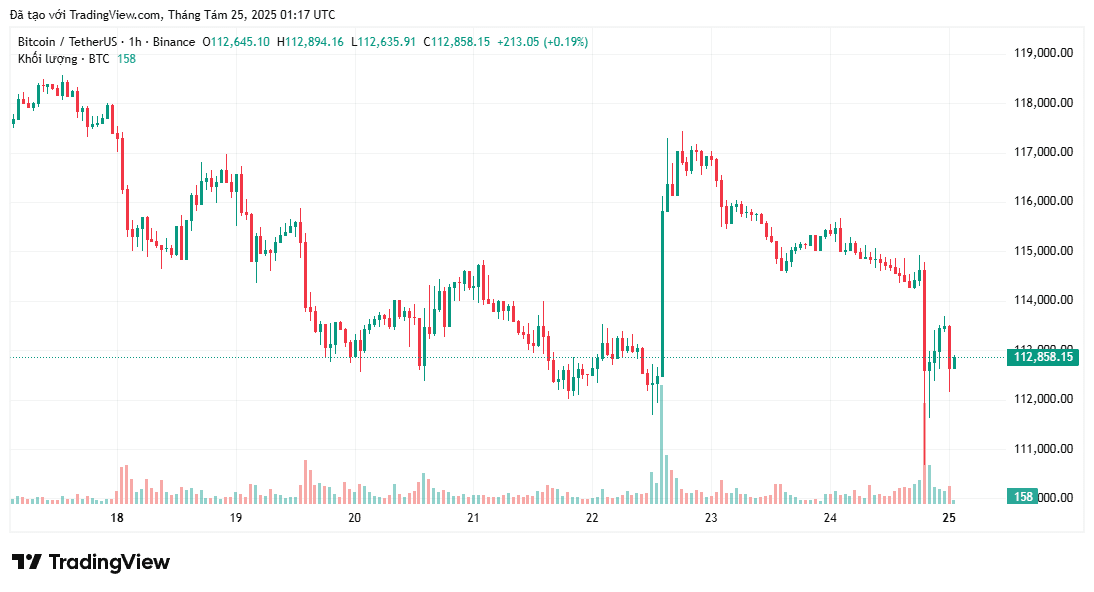The cryptocurrency market has seen a strong recovery following Federal Reserve Chair Jerome Powell's speech at Jackson Hole last week. Although Powell's policy changes appeared 'hawkish' in theory, his tone regarding concerns related to the labor market has increased investor confidence. Bitcoin rose by 4% and Ethereum surged over 13%, with markets now expecting a rate cut in September.
Market reversal: All eyes on the Fed's pivot
Following Jerome Powell's much-anticipated speech at Jackson Hole, the cryptocurrency market shifted to a positive trend last week. Powell's tone shift and heightened expectations for a rate cut in September caused risk assets, including Bitcoin, to soar despite his speech being potentially 'hawkish.'
Jay Powell's speech at Jackson Hole raised concerns about a long-term 'hawkish' stance, but the outcome brought unexpected optimism. Bitcoin rose about 4% and Ethereum surged over 13% after the speech as investors focused on the subtle change in Powell's attitude.
The Fed announced the end of the 'Average Inflation Targeting' (AIT) framework in a significant policy shift. This policy previously allowed them to accept inflation slightly above the 2% target. The central bank has indicated a cautious stance, requiring significant weakness in the labor market before cutting interest rates.
These changes could theoretically be seen as negative, making future monetary easing more difficult. However, the market has rebounded. The main reason is the significant shift in Jerome Powell's tone.
Not long ago, at the July FOMC meeting, Powell firmly prioritized inflation, drawing a clear line against immediate rate cuts. However, at Jackson Hole, he repeatedly emphasized the risks to the labor market. He stressed the need for policy adjustments, which many see as a signal for rate cuts.
Powell also downplayed concerns about inflationary pressures from the Trump administration's tariff policies, deeming them 'transitory.' He argued that a cooling labor market would prevent these temporary price shocks from turning into lasting inflation.
This is seen as a signal that the Fed is now emphasizing job stability over strict inflation control.
Is the September rate cut a 'done deal'?
Comments made immediately after Powell's speech reinforced market enthusiasm. James Bullard, former president of the Federal Reserve Bank of St. Louis and a prominent voice on monetary policy, stated in an interview with CNBC that Powell's remarks were effectively a signal for a 25 basis point rate cut in September.
Bullard's comments have removed any remaining doubts for many investors. He also raised expectations for a looser cycle by suggesting that there could be space for cuts of up to 100 basis points next year.
Powell noted that any rate cuts should not be seen as the beginning of a prolonged easing cycle. 'Whatever happens, we won't let a single price spike become a long-term inflation problem,' he said. This could suggest that the Fed may consider a maximum of two cuts this year.
However, there are still views that the Fed should restrain from further rate cuts. Federal Reserve Bank of Kansas City President Jeffrey Schmid, in an interview with Yahoo Finance, emphasized that while the labor market shows some signs of cooling, he sees inflation still close to 3% rather than the 2% target and warned against easing too quickly.
Schmid said, 'We still have a long way to go to bring inflation down to 2%. Cutting rates too early could spark demand and give companies greater pricing power.'
Federal Reserve Bank of Cleveland President Beth Hammack emphasized that inflation remains too high and trending upward, while the labor market is stable at around 4.2% unemployment. In an interview with Yahoo Finance, she said, 'If the meeting were tomorrow, I wouldn't see any reason to cut rates.'
Ethereum shines, but is it sustainable?
Last week saw a clear divergence in the cryptocurrency market, with Ethereum's strength overshadowing Bitcoin's weakness. Despite the positive macro environment following Jackson Hole, Bitcoin ended the week down 2.56%, recording a sharp decline of about $10,000 in just ten days. In contrast, Ethereum posted a weekly gain of 8.98%, with data showing renewed buying interest from Digital Asset Trading (DAT) firms.
This trend is also reflected in the flow of U.S. spot ETFs. According to Farside Investors, Bitcoin spot ETFs saw a significant net inflow of $1.178 billion last week. Meanwhile, Ethereum spot ETFs recorded a much smaller net inflow of only $241.1 million.
While some analysts, such as those at VanEck, maintain an optimistic year-end price target for Bitcoin of $180,000, the current market momentum seems to favor Ethereum.
Key indicators this week: August PCE inflation
Just before the Asian day trading opened on Monday, Bitcoin dropped to a six-week low of $110,600, wiping out Friday's gains. Most altcoins, including previously strong Ethereum, were pulled down along with Bitcoin's sudden decline. Bitcoin temporarily recovered above $113,000 but fell back to $112,858 at the current time.

Although Powell opened the door for a cut in September, his cautious tone suggests that this decision is not yet clearly defined. The global market's subsequent reaction today, as the initial excitement from Friday waned, will shape sentiment for risk assets this week.
Despite Ethereum's strong momentum, some market experts are concerned about the potential for a 'September slump.'
This Friday will be crucial. The August Personal Consumption Expenditures (PCE) price index, the Fed's preferred inflation measure, will be released, and the Michigan University inflation expectations survey will also be published on the same day.
These two indicators will provide essential clues to assess the economic backdrop before the September FOMC meeting. We wish all readers a successful investment week.